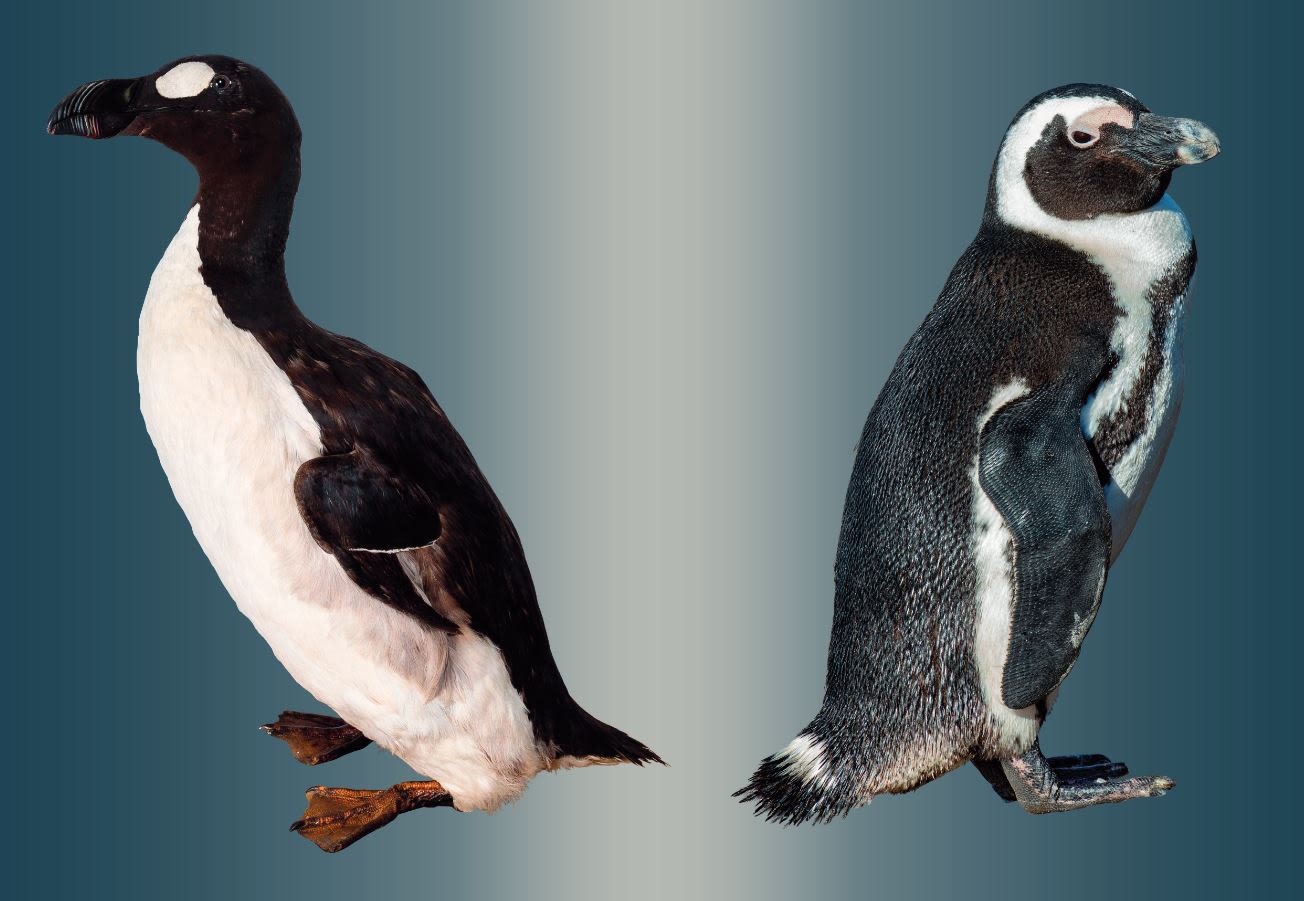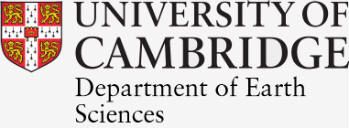Same but different:
The “aukward” truth about penguins and their flightless doppelgangers

What animal is black and white, waddles clumsily on two webbed feet and is an adept swimmer? Clue: it’s not a penguin...
We’re thinking of the now-extinct great auk, Pinguinus impennis, which, just like penguins, could not fly. Even though both animals look similar, and are completely flightless, great auks are only distantly related to penguins.

Great Auks by John James Audubon, from The Birds of America (1827–1838). University of Pittsburgh / Creative Commons.
Great Auks by John James Audubon, from The Birds of America (1827–1838). University of Pittsburgh / Creative Commons.
Sometimes, distantly related organisms that live in similar habitats can develop similar traits – in this case, the stubby flippers that great auks and penguins use to propel themselves through water. Biologists call this phenomenon “convergent evolution”, since distantly related groups may converge on a similar appearance. But adaptations in different organisms are not always identical, and those small differences can be hard for scientists to explain.

Birds of a feather: the Great Auk (left) and African Penguin (right) © University of Cambridge / Chris Green
Birds of a feather: the Great Auk (left) and African Penguin (right) © University of Cambridge / Chris Green
A new detailed examination of extinct auks and modern-day penguins gives us rare insight into the extent of the differences in their wings, arguing that these distinctions are ancestral hang-ups, carried down their separate evolutionary lineages over time.
The study was led by University of Cambridge researchers Dr Junya Watanabe, postdoctoral fellow in Earth Sciences, and Dr Daniel Field, lecturer in Earth Sciences and Curator of Ornithology at the University Museum of Zoology.

“We show that ancestral starting points have a strong impact on the minor differences we see in convergently similar species like penguins and auks,” said lead author Dr Watanabe.
“That’s really exciting for evolutionary biologists, who have been trying for decades to understand how these minor differences come about in animals with similar forms, and whether they can be predicted by our prior knowledge”.

Great auks – which vanished from the shores of the North Atlantic during the 19th century – are part of the Alcidae family of birds, which has 24 living species including guillemots and puffins.
All of their relatives can fly, though not very gracefully, but prefer to spend most of their time in water. It is thought that sailors – who discovered the look-alike penguins of the southern hemisphere at a later date – actually coined the name “penguin” after the Latin name for great auks.

The "Great Auk, Northern Penguin, or Gair-Fowl", wood engraving by Thomas Bewick in A History of British Birds, 1804. Thomas Bewick / Creative Commons
The "Great Auk, Northern Penguin, or Gair-Fowl", wood engraving by Thomas Bewick in A History of British Birds, 1804. Thomas Bewick / Creative Commons

A map showing the range of the great auk, with the coasts of North America and Europe forming two boundaries, a line stretching from New England to northern Portugal the southern boundary, and the northern boundary wrapping around the southern shore of Greenland. Creative Commons.
A map showing the range of the great auk, with the coasts of North America and Europe forming two boundaries, a line stretching from New England to northern Portugal the southern boundary, and the northern boundary wrapping around the southern shore of Greenland. Creative Commons.
Our understanding of the wings of flightless auks, their muscle structure and how they moved, has long been limited because we only have skeletal remains.

The new research, published in the journal Integrative Organismal Biology, is the first to reconstruct the wing muscles and ligaments of extinct auks by looking at the impressions that these soft tissues left behind on their bones. The new reconstructions used hundreds of fossil specimens of Pinguinus impennis and Mancalla, another relative who lived in the North Pacific and evolved its flightlessness independently, some of which were housed at Cambridge’s Museum of Zoology. The team also gathered comparative anatomical data from modern bird relatives, including shorebirds and the broader group of waterbirds that includes penguins.






Atlantic Puffin (Fratercula arctica) in flight, part of the Alcidae family of birds. © Daniel Field.
Atlantic Puffin (Fratercula arctica) in flight, part of the Alcidae family of birds. © Daniel Field.

Common Murre (Uria aalge), part of the Alcidae family of birds. © Daniel Field.
Common Murre (Uria aalge), part of the Alcidae family of birds. © Daniel Field.

Razorbill (Alca torda), a member of the Alcidae family of birds. © Daniel Field.
Razorbill (Alca torda), a member of the Alcidae family of birds. © Daniel Field.

Atlantic Puffin (Fratercula arctica). © Daniel Field.
Atlantic Puffin (Fratercula arctica). © Daniel Field.
Ornithologists have been aware of the many similarities in the anatomy of auks and penguins since the 1950’s. They noted their strangely compressed wing bones, with elbow and wrist joints apparently lacking mobility: making the wings more like rigid paddles.
The new study finds that, although extinct and living flightless birds are often seen as textbook examples of convergent evolution, there are fine differences in the wing muscles of great auks and penguins that can only be explained by their distinct origins. For example, they use different ligaments to enhance the rigidity of the elbow joint. The auks made use of a unique ligament that likely descended from their flying, non-diving ancestors, whereas penguins, lacking this ligament, modified other ligaments around the elbow.
Evolutionary biologists have long debated whether replaying the tape of life would give the same results, or whether the outcomes are completely unpredictable – being shaped by random events that affect evolutionary trajectories differently each time.
The team’s work emphasizes that evolution may be more predictable given a particular set of starting conditions. “What we see in the penguins and auks seems to point to a combination of predictable evolutionary trajectories driven by adaptation, and the unpredictable retention of some ancestral features, so the evolutionary starting points of convergent lineages also matter,” said Watanabe.
Read more J., Field, D. J., & Matsuoka, H. (2021). Wing musculature reconstruction in extinct flightless auks (Pinguinus and Mancalla) reveals incomplete convergence with penguins (Spheniscidae) due to differing ancestral states. Integrative Organismal Biology, 3(1), obaa040.


